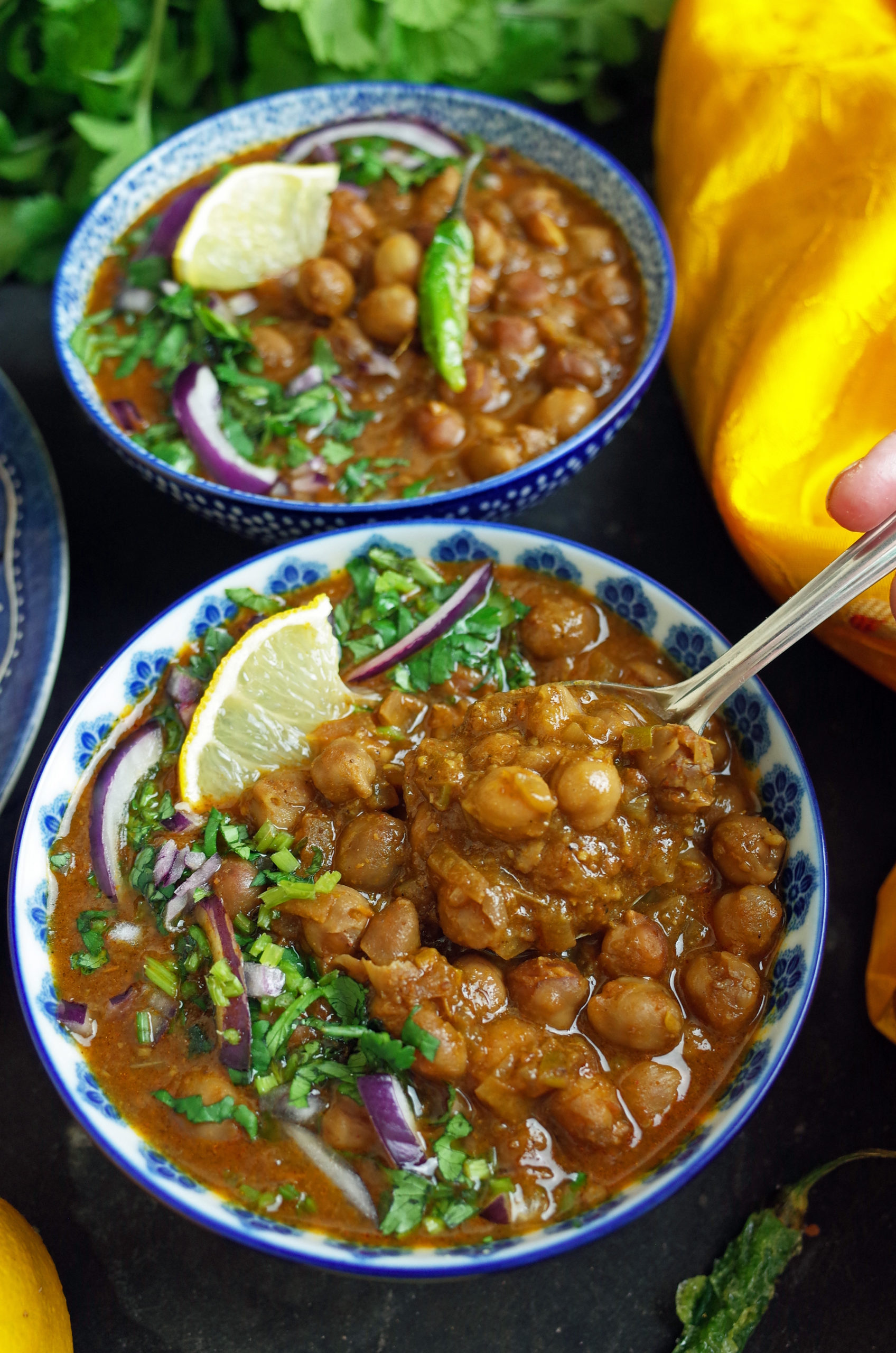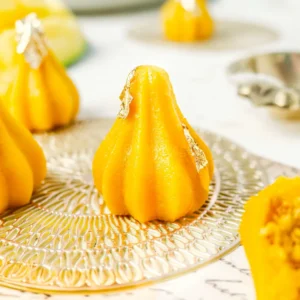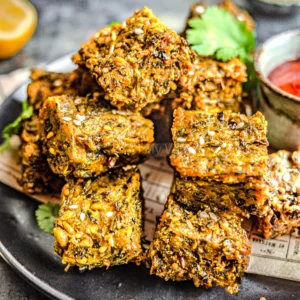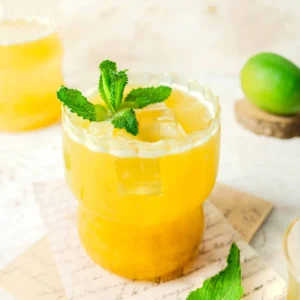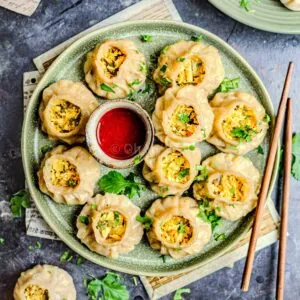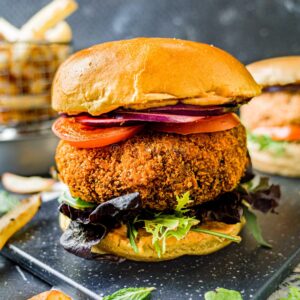Pakistani Chana Masala
This Pakistani chana masala, cooked in the Pakistani Punjab style, is easily in my top five recipes. The recipe below results in a beautiful, authentic curry that’s hearty, wholesome, rich, and spicy with a true depth of flavour.

So what exactly is chickpea curry? Well, this dish is technically more ‘Punjabi chole’ as it features heavy use of aromatic spices and a rich, intense sauce; however, chana masala, the more homely version, is more commonly understood in the UK. Both the words ‘Chole’ and ‘Chana’ mean ‘Chickpeas’, and ‘Masala’ just means spices – so, ‘Spicy Chickpeas’! It’s a North Indian recipe with a rich sauce made from fresh tomatoes, onions, ginger, garlic, and lots of accessible spices.
Tangy lemon juice and tamarind offer a subtle sourness to the dish, which counteracts the fiery spice from both green chilli and red chilli powder. Background notes of aromatics like cardamom, cinnamon, and cloves each offer their own unique flavours tinged with sweetness, while fresh red onions add to the richness of the dish by melting into the sauce. Plus, there’s a secret ingredient I’ll tell you more about later …
A squeeze of lemon juice, a sprinkling of fresh citrusy coriander on top, and a good bhature or puri to scoop up the chickpeas – it’s no wonder this dish is essential in North Indian Weddings – it’s one of the best things you can imagine eating.
Is this Chickpea Curry Vegan, Nut Free and Gluten Free?
Yes, it is! Chickpea curry is extremely popular with people following a Vegan lifestyle, and it’s easy to see why: The dish is completely plant-based, only using fresh spices and vegetables alongside the chickpeas.
On top of this, Chana Masala is also Nut Free, Gluten Free, Diary Free and Sugar Free. As a result, it’s a great dish to serve at any occasion as it’s suitable for people following most lifestyles/diets.
So, what’s this secret ingredient?!
Okay, I won’t keep you waiting any longer! The secret ingredient in this chickpea curry is actually tea.
Yes, you heard that right! In this recipe, the chickpeas are soaked in tea so they develop a really rich, deep brown colour. We use the same water that the chickpeas and tea are seeped in to form the basis of the curry later so as to not waste that lovely flavour. Don’t worry, the dish doesn’t taste of tea (I can assure you of that because I actually don’t like tea!,) but what does happen is that it gives a background umami flavour which is full of depth and richness.
Even though it may be strange or odd at first, I implore you not to skip using the tea – it really makes a difference!
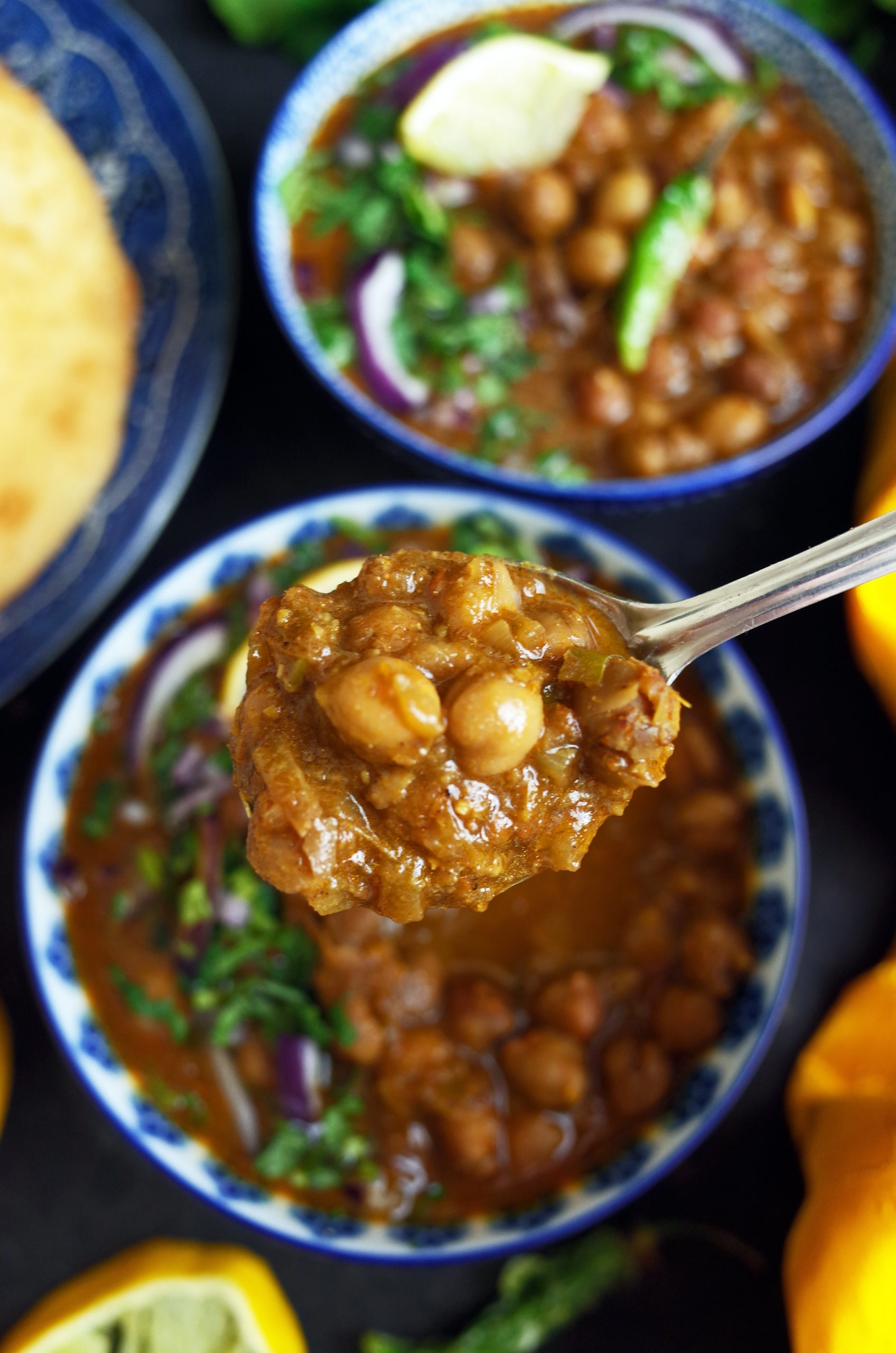
Can I use Dried Chickpeas or Canned Chickpeas for Vegan Chana Masala?
In this recipe, I’ve used canned chickpeas. I always have a tin of chickpeas in the cupboard so I can make a quick meal whenever I want, without going through the hassle of having to prepare and soak dried chickpeas in advance of when I want to cook. In addition, tinned chickpeas are a great budget-friendly option, and one tin easily feeds two adults. They are easily available in any supermarket as well as specialist Asian stores, but you can also buy online – I love this Organic brand (As an Amazon affiliate, I earn a small commission from every purchase made through this link)
Dried chickpeas are better if you have the time to pre-soak them in advance of cooking. They have a great flavour and are more versatile, being suitable for delicious recipes like falafel too. With a large pack like this, you’ll be able to make as much chickpea curry as you like, plus falafels, hummus and chaat! (As an Amazon affiliate, I earn a small commission from every purchase made through this link)
You can still follow this recipe using dried chickpeas, just be sure to soak them in plenty of water overnight. Next, you’ll need to rinse them, add around 600ml of water and a teabag to a pan and cook the chickpeas for around 1 hour or until soft. If you have a pressure cooker, this can be done in as little as 15 minutes. Exactly the same as in the recipe below, be sure not to throw away the water that you cook the chickpeas with – this is infused with a beautiful flavour and will be used to form the basis of our curry gravy later. Leave the chickpeas to soak for a few hours in the cooking water and follow the recipe as usual from then on.
This Chickpea Curry is…
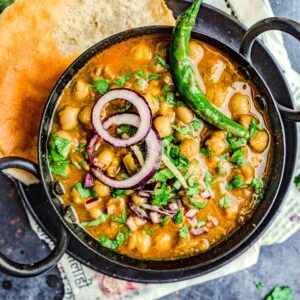
Pakistani Chana Masala
Ingredients
To Soak the Chickpeas:
- 1 can Chickpeas drained
- 500 ml Hot Water to soak the chickpeas
- 1 Teabag to soak the chickpeas
To Soak the Tamarind:
- 1 tbsp piece of Pure Tamarind Block
- Few tbsps hot water
For the Curry:
- 3 tbsp Sunflower Oil or to taste
- 1 Star Anise
- 1 ″ piece of Cinnamon
- 2 Green Cardamom
- 3 Cloves
- 1 Tej Patta Indian Bay Leaf
- 4 Green Finger Chillis finely chopped
- 1 Large Red Onion finely chopped (120g)
- 1 tbsp Ginger-Garlic Paste
- 2 Large Fresh Tomatoes pureed (200-240g)
- 3/4 tsp Salt or to taste
- 1/4 tsp Turmeric Powder
- 1 tsp Cumin Powder
- 2.5 tsp Coriander Powder
- 1.5 tsp Extra Hot Chilli Powder
- 1 tsp Garam Masala
- 1 tsp Lemon Juice
- Fresh Coriander to gar
- Ginger julienned, to garnish (optional)
Instructions
- This curry requires some advance preparation time. 5 hours before you plan to cook, drain a can of chickpeas*. Boil 500ml water in a kettle or medium saucepan. Add the drained chickpeas and teabag to a saucepan and pour the boiling water on top. Cover this saucepan and set it aside to soak for at least 5 hours (or up to overnight, kept in the fridge).
- 30 minutes before making the curry, take some pieces of pure tamarind equalling about 1tbsp and place it in a small bowl. Pour a few tablespoons of hot water over the tamarind and leave to soak.
- To make the curry, heat oil in a large kadai or metal saucepan over medium-low heat. Once the oil is hot add the aromatic spices – star anise, cinnamon, green cardamom, cloves, and Indian bay leaf. Gently sauté until aromatic, taking care to not overcook. Then add the green chilli and let them sizzle a little before adding chopped onions and ginger-garlic paste. Sauté for a few minutes, stirring frequently to avoid sticking, until the onions are translucent and there is no raw smell remaining from the ginger and garlic.
- At this stage add the fresh pureed tomatoes and salt. Cook on low heat consistently for around 5-10 minutes (the time it takes depends on your stove), stirring frequently to prevent burning on the bottom. You want to cook the tomato until it becomes thick, gathers together when stirred, and oil releases from the sides. Once this happens add the powered spices – turmeric powder, cumin powder, coriander powder and chilli powder. After that, mix everything thoroughly and cook for 30 seconds.
- Add the chickpeas and soaking water (but not the teabag) to the pan and mix everything once again. Set the heat to medium-low and cover the pan. Simmer the curry* until the curry reaches your desired thickness – I like mine with a little gravy. Add the tamarind by holding a tea strainer above the pan and pushing the tamarind paste through, leaving the seeds behind and the paste in the curry. Next add the lemon juice and garam masala. Simmer for 5 more minutes and then serve garnished with fresh coriander and julienned ginger.
Notes
Equipment
Nutrition
Can you freeze this Vegan Chana Masala?
Yes, chickpea curry is great because you can easily freeze it and reheat it later in the week for a quick and easy meal. Many people even say that the flavours develop further while in the freezer and make it even tastier!
To freeze the curry, allow it to cool completely after cooking and then portion it up in freezer-suitable containers. It will stay in the freezer for around 6 months, and defrosting is a breeze. Simply allow it to thaw in the fridge and then reheat the curry in a pan until piping hot. Freezing can dry out the sauce, so you may have to add a little extra water when reheating to create a gravy. Garnish with fresh coriander only after reheating, as the herb has a gentle flavour that doesn’t adapt well to freezing.
